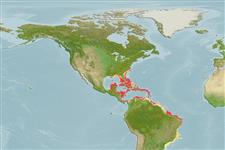Preferred temperature (Αναφ.
123201): 22.8 - 28, mean 26.4 °C (based on 400 cells).
Phylogenetic diversity index (Αναφ.
82804): PD
50 = 0.5000 [Uniqueness, from 0.5 = low to 2.0 = high].
Bayesian length-weight: a=0.01175 (0.01020 - 0.01353), b=3.04 (3.01 - 3.07), in cm total length, based on LWR estimates for this species (Ref.
93245).
Τροφικό Επίπεδο (Αναφ.
69278): 4.1 ±0.0 se; based on diet studies.
Ελαστικότητα (Αναφ.
120179): Χαμηλό, ελάχιστος χρόνος για διπλασιασμό πληθυσμού 4,5 - 14 έτη (Musick et al. 2000 (Ref.
36717)).
Prior r = 0.43, 95% CL = 0.28 - 0.64, Based on 1 data-limited stock assessment.
Fishing Vulnerability (Ref.
59153): High vulnerability (63 of 100).
🛈
Climate Vulnerability (Ref.
125649): Very high vulnerability (82 of 100).
🛈
Nutrients (Ref.
124155): Calcium = 15.2 [7.2, 34.8] mg/100g; Iron = 0.444 [0.224, 0.890] mg/100g; Protein = 18.4 [16.8, 19.9] %; Omega3 = 0.106 [0.063, 0.178] g/100g; Selenium = 46.3 [23.9, 93.4] μg/100g; VitaminA = 201 [51, 791] μg/100g; Zinc = 0.995 [0.670, 1.432] mg/100g (wet weight);
